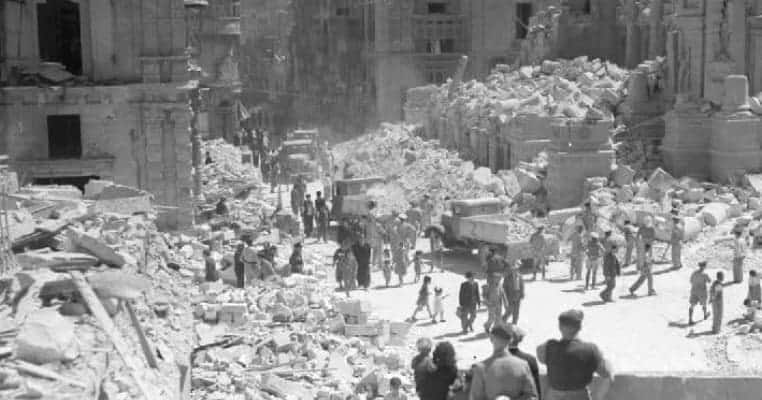The island of Malta is situated roughly in the center of the Mediterranean Sea, about 175 miles east of Tunisia, 200 miles north of Libya, and 50 miles south of Italy. A British possession since 1800, Malta’s strategic location rendered it vitally important to both the Axis and Allies during World War II’s North African Campaign. So the Italians and Germans did their best to try and wrest the island from the British by bombing and starving it into surrender, or at least render it useless as a military base.
The British – and the Maltese people – put up a heroic fight to keep the island supplied, and a going concern as a fortress from which to foil the Axis’ plans in the Mediterranean. The result was a ferocious campaign, from 1940 to 1942, that pitted the German and Italian navies and air forces against the British Royal Navy, Royal Air Force, and the Maltese people. The island suffered heavily, with the heaviest punishment falling upon the densely populated capital city of Valetta, and the adjacent harbor. Those areas, measuring about 0.75 square miles, were subjected to history’s most sustained and concentrated bombing campaign.

Malta’s Strategic Importance
With Malta in Allied hands, warships and warplanes operating from the island were well positioned to interdict and harry convoys ferrying supplies and reinforcement from depots in Italy to Axis forces in North Africa. In Axis hands, Malta would have interdicted Britain’s Mediterranean links to Egypt, and severed communications and coordination between British forces in the Eastern Mediterranean from those in Gibraltar.
Early in the war, the British reasoned that Malta’s proximity to Italy rendered it indefensible. So they withdrew the bulk of their fleet and relocated it to Alexandria, Egypt, and stripped the island of airplanes. Luckily, the aircraft carrier HMS Glorious had ditched some crates of obsolescent Gloster Sea Gladiator fighters in Malta during a stopover in early 1940, and local assembled six of them into an ad hoc squadron. They were flown by pilots who had trained on airboats and transports, but who lacked any experience with fighter aircraft.
When Axis operations against Malta began after Italy joined the war in June of 1940, the six Gladiator biplanes were all the fighter cover the island had. Operating out of the RAF’s Hal Far airfield, they came to be known as the “Hal Far Fighter Flight”, and because no more than three of them flew at once, the ones in service were nicknamed “Faith”, “Hope”, and “Charity”. The Gladiators might have been obsolescent, and their pilots inexperienced and untrained, but they put up a spirited fight starting with the first day’s fighting, when the Italians sent about 120 bombers and dozens of fighters to bomb and strafe. One of the defending Gladiators was shot down, but the rest shot down several Italian airplanes in turn.

A series of flukes had created Malta’s defensive air force, and another series of flukes ended up creating the nucleus of the island’s offensive aerial arm. It commenced with twelve Royal Navy Fleet Air Arm Fairy Swordfish torpedo bombers showing up out of the blue, to land at the Hal Far airfield on June 19th, 1940. It was the culmination of a journey that began in southern France, which the biplanes had fled just days ahead of the French surrender to Germany. They made their way to airfields in French Tunisia, but lack of security there prompted them to seek somewhere safer. So they flew to Malta. The locals quickly put them to use, and within little more than a week, the new arrivals had raided Sicily, sank an Italian destroyer, damaged a cruiser, and destroyed oil storage tanks in the port of Augusta.
Despite the pluckiness of Malta’s defenders, the Italians probably could have captured the island in those early months if they had mounted a determined air and sea attack, combined with an amphibious landing. The garrison was simply too small to offer serious resistance, and the British were busy fighting for their lives at home in the Battle of Britain. They had little attention to give a tiny Mediterranean island that they had already written off as indefensible.

